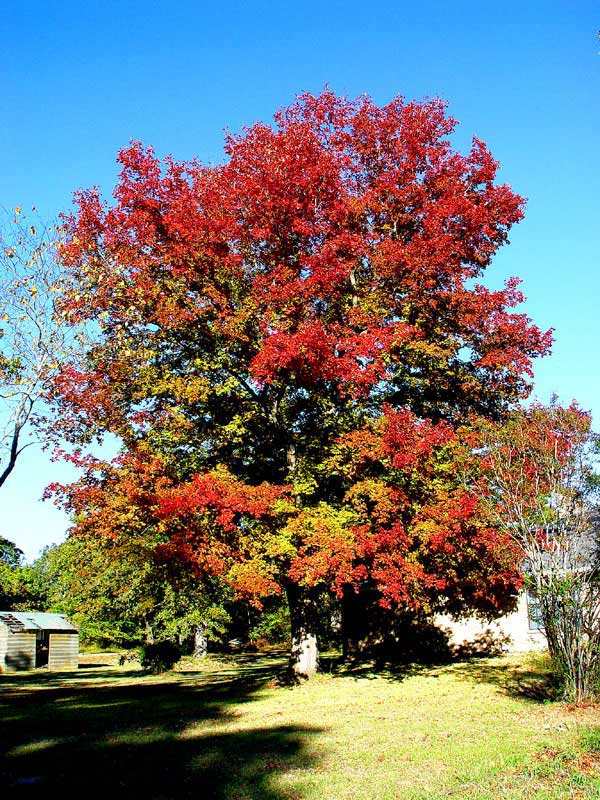RiskVA
Fall – A Refreshing Pause 5 Nov 2008
On the 22nd of September, Earth orbited around the sun to a position that caused our night and day to be equal. Called the autumnal equinox, it signaled that fall was officially here. Since then, the days have begun to grow shorter and the noonday sun has now slipped even farther down the southern sky. Because of the 23 ½-degree tilt of Earth’s axis, incoming radiation from the sun is not so direct, warming the surface of the land less each day.
Precious heat is leaking into the black void of space and our weather is gradually becoming cooler. The days will continue to shorten until December 22nd, the time of the winter solstice, when night will begin to relinquish its hold on our planet. Cold or at least crisp weather can still hold us in its grip well into March. Then, about the 20th of March, Earth’s orbit will have swung around far enough that once again day and night will be equal, a time called the vernal or spring equinox. Here in East Texas, noticeable warming usually begins in February as Camellias begin to bloom and buds to swell, but even then, we can still get hit with cold snaps and ice storms.
In the meantime, animals and plants have now begun to sense the reduced day length and their behavior and physiology is changing. Those that are “wise,” such as bees, ants and squirrels, are storing winter supplies for the harder times ahead. Grasshoppers are everywhere and as in Aesop’s Fables, they are wasting their time buzzing around trying to sound like flying rattlesnakes, enjoying the last days of warmth, ignorant and oblivious to their coming demise.
Butterflies are sipping final drinks of nectar from the few remaining flowers to fortify themselves to lay a last batch of eggs. Yellowjackets have entered their Eat-Drink-And-Be-Merry phase, refusing to nurse larvae and instead feeding on fallen fruit or picnic goodies, even soft drinks and beer whenever they can, leaving panic stricken people in their paths. They and other wasps will all die as winter comes on, with the exception of a few fertilized females that will overwinter to start next season’s crop of winged zingers. Hummingbirds are in short supply. Ours have headed south.
Cats, dogs, coyotes, raccoons and other mammals are growing a thick undercoat of fine-textured, insulating fur.
Sumac berries are glowing in fuzzy, reddish pinnacles along our roadsides, from which a pleasant lemonade-like beverage can be made. We call it Rhus Juice, from the scientific name for sumac. Put the berries in water and stir vigorously. Then strain the reddish liquid through cheesecloth to get the fuzz and other debris out. Add sugar as desired.
Maples, oaks, and sweet gums will soon turn bright red as the chlorophyll they’ve been using to make food during the growing season is destroyed, revealing bright colors the green concealed. And no, Jack Frost has little to do with fall colors. In fact, too much frost and the leaves just turn brown and fall off.
In the fall, humidity usually drops and evenings are pleasantly cool or even brisk. The night skies glitter with stars that summer’s haze obscured. By 9 PM the constellation Orion The Hunter, is creeping over the eastern horizon. It will dominate the winter months, rising higher in the sky each evening.
In short, fall is a time of lazy, chirping crickets, maturing crops, and glowing full moons. The Full Harvest Moon rose September 15th and the Full Hunters Moon on October 14th. November 13 will usher in the Full Beaver Moon – also called the Full Frosty Moon.
Fall is a time when the pace of outdoor life slows, and maybe ours should too. It’s a great time for family activities outside. Get away from the ding blasted TV! Take a walk in the woods. Sit out in the evening. Watch the sun set and the stars rise. Take a deep breath and watch the last flights of dragonflies, chimney swifts, and geese. Expand your awareness. Reach out with your senses. Feel the breeze. Sniff the air, it smells different now.
Learn to “feel” the outdoor world. Exercise your humanity. No other creature is as well equipped to appreciate the bounty, beauty and variety found in the fields and forest of East Texas this time of the year. It’s all ours – and it’s all free!
Dr. Risk is a professor emeritus in the College of Forestry and Agriculture at Stephen F. Austin State University in Nacogdoches, Texas. Content © Paul H. Risk, Ph.D. All rights reserved, except where otherwise noted. Click paulrisk2@gmail.com to send questions, comments, or request permission for use.

